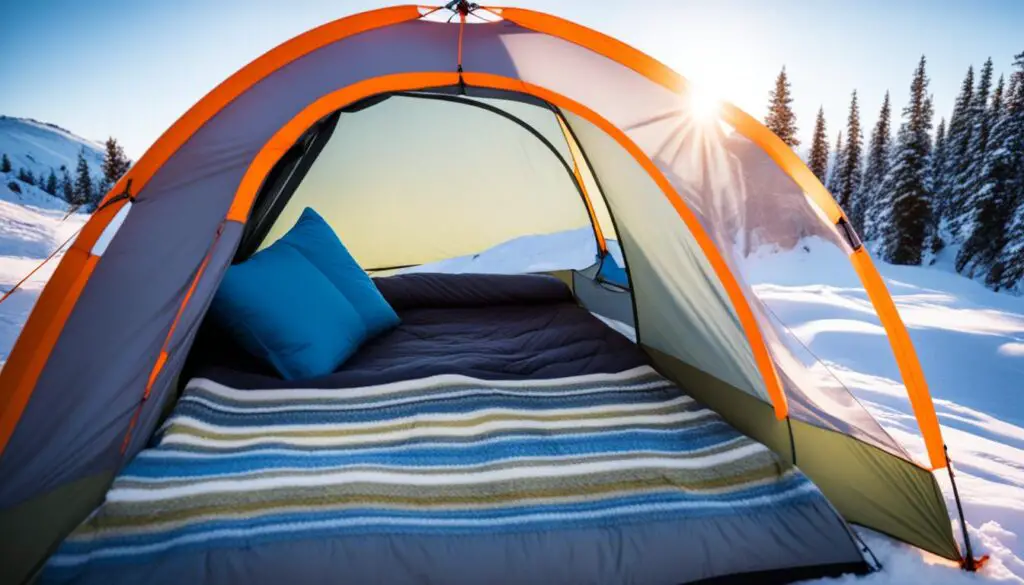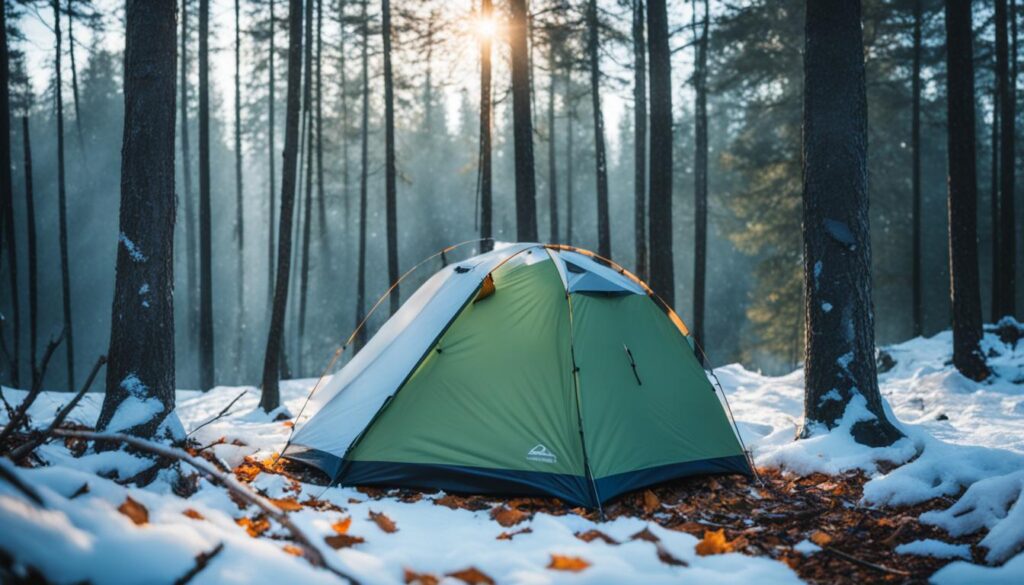How to Make Camping Tent Warmer
As a big fan of camping, staying warm is key during cold nights. In this guide, I’ll show how to make your tent cozier with the right techniques and gear. This way, you can sleep well, even when it’s very cold outside.
Planning a camping trip in winter or trying to camp later in the year? These methods will make your tent a warm spot, keeping you comfortable. With the tricks I’ll share, you can beat the cold and enjoy camping any time, any season.
Mastering the Art of Staying Toasty on Chilly Camping Nights
Staying warm in a camping tent can be a tough task, especially when it’s cold. We will look at why tents lose heat and how to make a snug spot. This will make your outdoor trips much more enjoyable.
Understanding the Challenges of Tent Warmth
Keeping a tent warm is not easy at all. Tent insulation is usually thin. This means it lets cold air in, especially during cold weather camping. The wind, dampness, and how crowded the tent is can also decrease its warmth.
The Benefits of a Warm and Cozy Camping Experience
Having a warm and snug tent can change how you feel about camping. It doesn’t just keep you warm. It also makes you feel happier and more energized. This makes the outdoors feel more inviting. With a cozy tent, you can sleep well and be ready for the next day’s fun, instead of being cold all night.
Knowing the hurdles and rewards of a warm camping trip can help you get ready for the cold. It makes your time in the wild better.
Essential Gear for Tent Heating
It’s vital to stay warm in your tent for a good time. This is especially true when it gets cold at night. To make your tent warm, choosing the right gear is key. We will look at what you need to stay warm, like heaters and insulation.
Portable Heaters: Choosing the Right One
Portable heaters can make your tent much warmer. The Mr. Heater Little Buddy propane heater is a top pick. It costs $105 and lasts about five hours on a small propane tank. It puts out 3,800 BTUs, perfect for a small to medium tent. Another choice is the Mr. Heater Buddy propane heater. It gives off 9,000 BTUs. But, it doesn’t have a fan to spread the heat around. So, you’ll need to point it at yourself to get warm.
If you need a stronger heater, consider a portable diesel one. These start around $1,700 and weigh about 30 pounds. They need careful setting up to work right at different heights. Some might not work well above 8,000 feet.
Insulating Materials and Reflective Barriers
Using portable heaters is good but adding insulation is even better. It helps keep the heat in and the cold out. The SnowTrekker Basecamp canvas wall tent is great. It’s priced at $2,000, with a spacious design and good for winter camping.
For sleep gear, a down sleeping bag is top choice for cold and dry weather. It’s light and warm. If you’re looking for something cheaper, synthetic insulation works too. An insulated sleeping pad, like the Big Agnes, helps keep your body heat in.
With the right gear, you can make your tent warm and comfy. This means you can enjoy camping even when it’s cold outside.
How to Make Camping Tent Warmer
Step-by-Step Guide to Setting Up Your Warm Haven
Turning your camping tent into a warm retreat is simple. Just follow a few steps. You can make a cozy space for outdoor adventures, even when it’s cold. Let’s see how to insulate your tent for a warm atmosphere.
Start by picking the right spot for your tent. Choose a place that’s sheltered and keeps warmth in. It should be away from the wind and close to nature. Places with trees, rocks, or other wind blocks are great for this.
- Insulate the floor: Put an insulating mat or foam under your tent. It stops the cold from the ground getting to you.
- Use reflective barriers: Add a reflective material to your tent’s walls and roof. This will keep the heat you make inside.
- Get a portable heater: A small, indoor-safe heater can keep your tent nice and warm. Make sure it’s well-ventilated for safety.
- Insulate the entrance: Cover any gaps around your tent door with insulating material. It stops the warm air from leaving and cold air from coming in.
- Use thermal fabrics: Think about using special fabrics for your sleeping bag, blankets, and clothes. They help keep your body heat close, making you feel warmer.
Just by doing these steps, your camping trip will be much warmer and more enjoyable. It’s all about preparing a bit beforehand. This way, you can be warm and make great memories outside.

Campfire and Outdoor Heating Techniques
To stay warm in your tent, you don’t always need electric heaters. Using nature’s heat can make your tent cozy. This section looks into using campfires, outdoor heaters, and other green ways to stay warm.
The Allure of Campfire Warmth
A campfire’s crackle and warmth are both calming and useful. It makes the outdoors feel homey. You can place your tent close to it to stay warm and dry.
Portable Outdoor Heaters: Convenient Heat Solutions
Outdoor heaters are handy for controlled heat, especially for those on the go. They are easy to move and set up near your tent. Make sure to consider the type of fuel, how much heat it gives, and its safety features.
Eco-Friendly Alternatives: Embracing Nature’s Warmth
Other than fires and heaters, there are green ways to heat your tent. Use materials like reflective barriers to keep heat in. Plus, solar power can also be a source of warmth. These methods are good for nature too.
| Heating Method | Advantages | Considerations |
|---|---|---|
| Campfire | Provides radiant heat, adds ambiance | Requires monitoring, potential fire hazard |
| Portable Outdoor Heater | Convenient, focused heat, easy to control | Fuel-dependent, potential safety concerns |
| Insulation and Reflective Barriers | Eco-friendly, no fuel required | Less immediate heating, requires setup |
| Solar-Powered Heating | Renewable, environmentally friendly | Dependent on sun exposure, limited heating capacity |
By looking at campfire tent heating and other methods, you can make your tent a warm place. This lets you enjoy your time outdoors more, no matter how cold it is.
Staying Warm Without Electricity
Camping without electricity doesn’t mean losing warmth and comfort. You can stay cozy in your tent, even on cold nights. There are many smart ways to stay warm while enjoying nature.
Low-Tech Solutions for Tent Heating
To stay warm camping without electricity, use natural materials and simple devices. Insulating materials like thermal blankets, sleeping bag liners, and reflective barriers are great. They help keep your warmth inside.
- Thermal Blankets: These sheets reflect your body’s heat, making a warm space in your tent.
- Sleeping Bag Liners: Use a liner in your sleeping bag for more insulation and heat.
- Reflective Barriers: Hang reflective materials on your tent’s walls to bounce heat back to you.
Another idea for non-electric tent heating is using portable heat sources. Hand warmers, chemical warmers, or a simple candle lantern are perfect. They give off heat gently and don’t need electricity.
- Hand Warmers: Put them in your sleeping bag or pockets for warmth.
- Chemical Warmers: These packs can go in your tent for extra heat.
- Candle Lanterns: They give off heat and a nice, warm light in your tent.
With these camping without electricity tips, you can have a cozy time outdoors. The power grid won’t affect your fun and warmth.
Safety Considerations for Tent Heating
Creating a warm and cozy tent is nice, but safety comes first. Heating devices can be dangerous, causing fires or carbon monoxide poisoning. I will share important steps to keep you safe while camping.
Avoiding Fire Hazards
Be careful when heating your tent. Keep heaters or stoves away from anything that burns easily. This includes fabrics and the tent. Make sure they can’t fall over and don’t leave them alone.
Also, it’s important to have good airflow in your tent. This helps reduce the chance of a fire.
Preventing Carbon Monoxide Poisoning
Carbon monoxide is a serious risk when heating a tent. It’s a gas you can’t see or smell, and it can hurt you. Always use safe heaters and keep the tent well-ventilated. You might also want to use a carbon monoxide detector.
FAQ
What are the most effective ways to insulate a camping tent and keep it warm?
Use insulating mats, reflective liners, and thermal curtains. Also, consider portable heaters made for tents. Place your tent well, seal out drafts, and use a campfire smartly. These steps help keep warmth inside your tent.
What type of portable heater is best for use in a camping tent?
Choose a heater for indoor/tent use. Make sure it’s safe and efficient. Look for features like automatic shut-off and tip-over protection. Propane and electric heaters work well for heating tents.
How can I prevent carbon monoxide poisoning when using a heater in my tent?
Always keep your tent well-ventilated when using a heater. Put it near an open flap or window. Don’t use heaters while you sleep. Having a carbon monoxide detector in your tent is very important.
What are some low-tech solutions for keeping a camping tent warm without electricity?
If there’s no electricity, try heating your tent with low-tech methods. Use hot water bottles, warm sleeping bags, and layered clothes. Cover the tent’s floor with tarps or foil for extra insulation. Don’t forget the heat from a campfire.
How can I properly set up my camping tent to maximize warmth and insulation?
Setting up your tent right is crucial for warmth. Pick a sheltered spot and a level ground. Use a pad on the floor and seal the tent for drafts. Place your heat source carefully. This makes your tent a cozy place.
